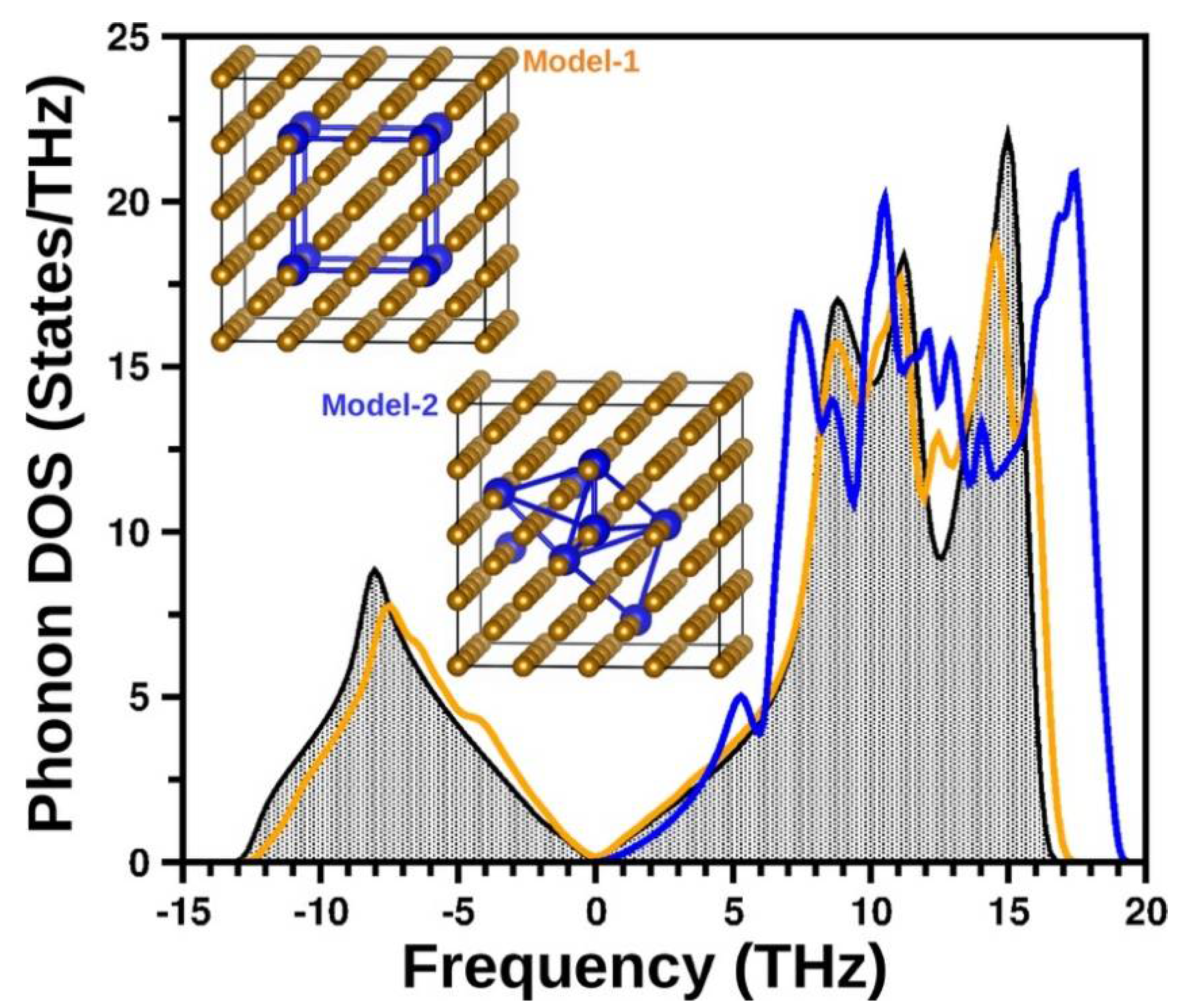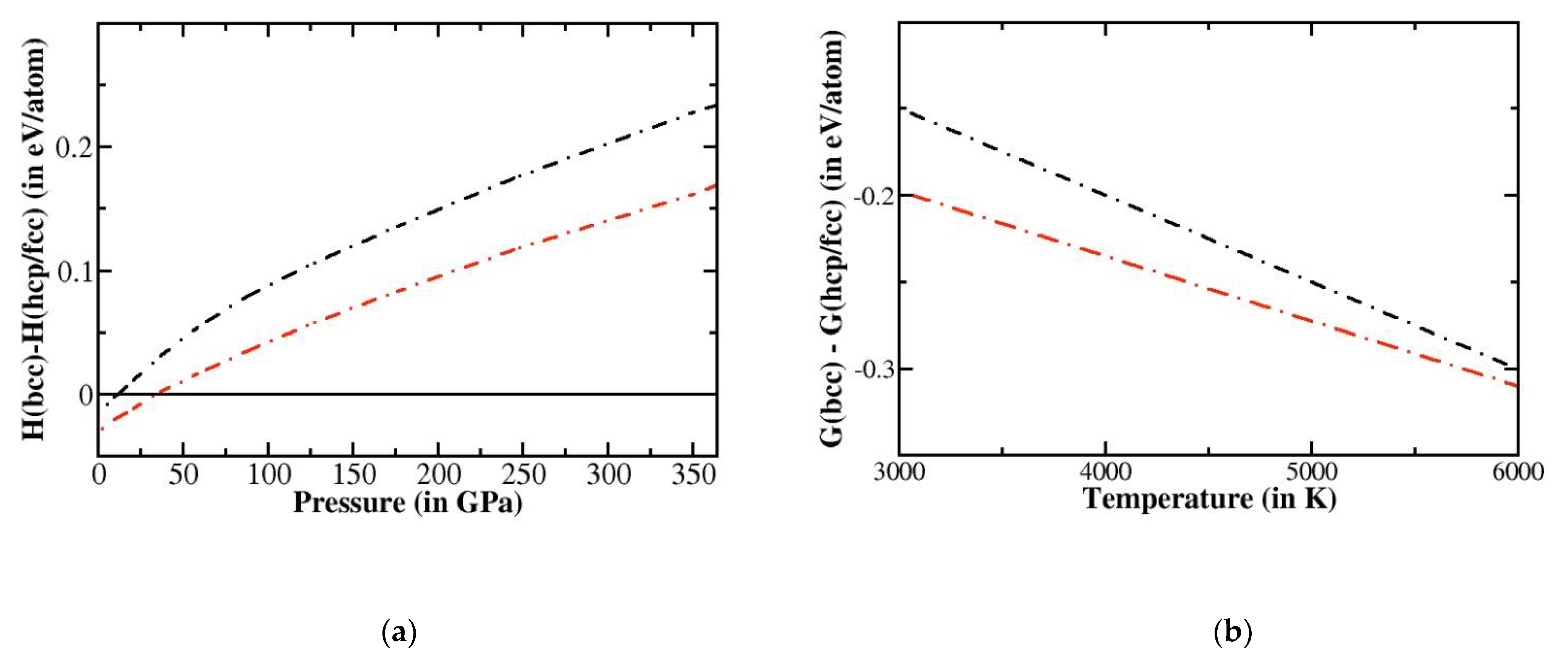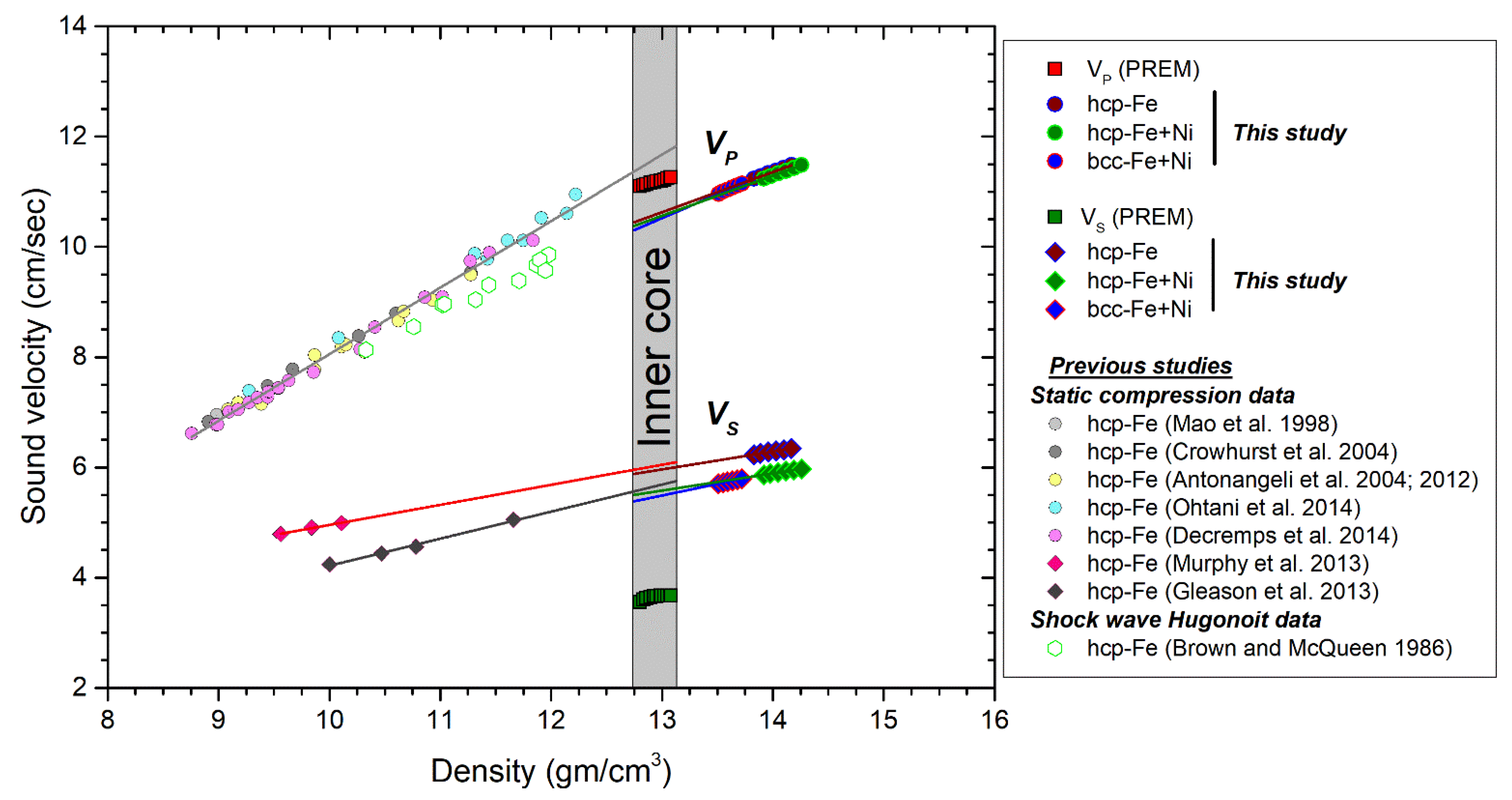Ni Doping: A Viable Route to Make Body-Centered-Cubic Fe Stable at Earth’s Inner Core
Abstract
1. Introduction
2. Methodology
3. Results
4. Discussion
5. Concluding Remarks and Implications
Supplementary Materials
Author Contributions
Funding
Acknowledgments
Conflicts of Interest
References
- Allégre, C.J.; Poirier, J.-P.; Humler, E.; Hofmann, A.W. The chemical composition of the Earth. Earth Planet. Sci. Lett. 1995, 134, 515–526. [Google Scholar] [CrossRef]
- Anderson, D.L. Theory of the Earth; Blackwell Scientific Publications: Hoboken, NJ, USA, 1989. [Google Scholar]
- Vočadlo, L.; Brodholt, J.; Alfe, D.; Price, G.D. The structure of iron under the conditions of the Earth’s inner core. Geophys. Res. Lett. 1999, 26, 1231–1234. [Google Scholar] [CrossRef]
- Belonoshko, A.B.; Ahuja, R.; Johansson, B. Stability of the body-centred-cubic phase of iron in the Earth’s inner core. Nature 2003, 424, 1032. [Google Scholar] [CrossRef]
- Anzellini, S.; Dewaele, A.; Mezouar, M.; Loubeyre, P.; Morard, G. Melting of iron at Earth’s inner core boundary based on fast X-ray diffraction. Science 2013, 340, 464–466. [Google Scholar] [CrossRef]
- Denoeud, A.; Ozaki , N.; Benuzzi-Mounaix, A.; Uranishi , H.; Kondon, Y.; Kodama, R.; Brambrink, E.; Ravasio, A.; Bocoum, M.; Boudenne , J.-M.; et al. Dynamic X-ray diffraction observation of shocked solid iron up to 170 GPa. Proc. Natl. Acad. Sci. USA 2016, 113, 7745–7749. [Google Scholar] [CrossRef]
- Tateno, S.; Hirose, K.; Ohishi, Y.; Tatsumi, Y. The structure of iron in Earth’s inner core. Science 2010, 330, 359–361. [Google Scholar] [CrossRef]
- Luo, W.; Johansson, B.; Eriksson, O.; Arapan, S.; Souvatzis, P.; Katsnelson, M.I.; Ahuja, R. Dynamical stability of body center cubic iron at the Earth’s core conditions. Proc. Natl. Acad. Sci. USA 2010, 107, 9962. [Google Scholar] [CrossRef]
- Aquilanti, G.; Trapananti, A.; Karandikar, A.; Kantor, I.; Marini, C.; Mathon, O.; Pascarelli, S.; Boehler, R. Melting of iron determined by X-ray absorption spectroscopy to 100 GPa. Proc. Natl. Acad. Sci. USA 2015, 112, 12042–12045. [Google Scholar] [CrossRef]
- Tateno, S.; Hirose, K.; Komabayashi, T.; Ozawa, H.; Ohishi, Y. The structure of Fe-Ni alloy in Earth’s inner core. Geophys. Res. Lett. 2012, 39, L12305. [Google Scholar] [CrossRef]
- Hirose, K.; Labrosse, S.; Hernlund, J. Composition and state of the core. Ann. Rev. Earth Planet. Sci. 2013, 41, 657–691. [Google Scholar] [CrossRef]
- Mao, W.L.; Campbell, A.J.; Heinz, D.L.; Shen, G.Y. Phase relations of Fe-Ni alloys at high pressure and temperature. Phys. Earth Planet. Inter. 2006, 155, 146–151. [Google Scholar] [CrossRef]
- Komabayashi, T.; Hirose, K.; Ohishi, Y. In situ X-ray diffraction measurements of the fcc–hcp phase transition boundary of an Fe-Ni alloy in an internally heated diamond anvil cell. Phys. Chem. Miner. 2012, 39, 329–338. [Google Scholar] [CrossRef]
- Kuwayama, Y.; Hirose, K.; Sata, N.; Ohishi, Y. Phase relations of Fe and Fe-Ni alloys up to 300 GPa: Implications for composition and structure of the Earth’s inner core. Earth Planet. Sci. Lett. 2008, 273, 379–385. [Google Scholar] [CrossRef]
- Vočadlo, L.; Dobson, D.P.; Wood, I.G. Ab initio study of nickel substitution into iron. Earth Planet. Sci. Lett. 2006, 248, 132–137. [Google Scholar] [CrossRef]
- Côté, A.S.; Vočadlo, L.; Brodholt, J.P. Ab initio simulations of iron-nickel alloys at Earth’s core conditions. Earth Planet. Sci. Lett. 2012, 345, 126–130. [Google Scholar] [CrossRef][Green Version]
- Martorell, B.; Brodholt, J.; Wood, I.G.; Vočadlo, L. The effect of nickel on the properties of iron at the conditions of Earth’s inner core: Ab initio calculations of seismic wave velocities of Fe-Ni alloys. Earth Planet. Sci. Lett. 2013, 365, 143–151. [Google Scholar] [CrossRef]
- Ekholm, M.; Mikhaylushkin, A.S.; Simak, S.I.; Johansson, B.; Abrokosov, I.A. Configurational thermodynamis of Fe-Ni alloys at Earth’s core conditions. Earth Planet. Sci. Lett. 2011, 308, 90–96. [Google Scholar] [CrossRef]
- Lin, J.F.; Heinz, D.L.; Campbell, A.J.; Devine, J.M.; Mao, W.L.; Shen, G. Iron-nickel alloy in the Earth’s core. Geophys. Res. Lett. 2002, 29, 1471. [Google Scholar] [CrossRef]
- Sakai, T.; Ohtani, E.; Hirao, N.; Ohishi, Y. Stability field of the hcp-structure for Fe, Fe-Ni, and Fe-Ni-Si alloys up to 3 Mbar. Geophys. Res. Lett. 2011, 38, L09302. [Google Scholar] [CrossRef]
- Torchio, R.; Boccato, S.; Miozzi, F.; Rosa, A.D.; Ishimatsu, N.; Kantor, I.; Sévelin-Radiguet, N.; Briggs, R.; Meneghini, C.; Irifune, T.; et al. Melting curve and phase relations of Fe-Ni alloys: Implications for the Earth’s core composition. Geophys. Res. Lett. 2020, 47, e2020GL088169. [Google Scholar] [CrossRef]
- Belonoshko, A.B.; Lukinov, T.; Fu, J.; Zhao, J.; Davis, S.; Simak, S.I. Stabilization of body-centered cubic iron under inner-core condition. Nat. Geosci. 2017, 10, 312. [Google Scholar] [CrossRef]
- Dubrovinsky, L.S.; Dubrovinskaia, N.A.; Narygina, O. Body-centered cubic iron-nickel alloy in Earth’s core. Science 2007, 316, 1880–1883. [Google Scholar] [CrossRef]
- Morelli, A.; Dziewonski, A.M.; Woodhouse, J.H. Anisotropy of the inner core inferred from PKIKP travel times. Geophys. Res Lett. 1986, 13, 1545–1548. [Google Scholar] [CrossRef]
- Woodhouse, J.H.; Giardini, D.; Li, X.D. Evidence for inner core anisotropy from free oscillations. Geophys. Res. Lett. 1986, 13, 1549–1552. [Google Scholar] [CrossRef]
- Song, X.D. Anisotropy of the Earth’s inner core. Rev. Geophys. 1997, 35, 297–313. [Google Scholar] [CrossRef]
- Beghein, C.; Trampert, J. Robust normal mode constraints on inner-core anisotropy from model space search. Science 2003, 229, 552–555. [Google Scholar] [CrossRef] [PubMed]
- Wenk, H.R.; Matthies, S.; Hemley, R.J.; Mao, H.K.; Shu, J. The plastic deformation of iron at pressures of the Earth’s inner core. Nature 2000, 45, 1044–1047. [Google Scholar] [CrossRef] [PubMed]
- Buffett, B.A.; Wenk, H.-R. Texturing of the Earth’s inner core by Maxwell stresses. Nature 2001, 413, 60–63. [Google Scholar] [CrossRef]
- Mattesini, M.; Belonoshko, A.B.; Tkalčić, H. Polymorphic nature of iron and degree of lattice preferred orientations beneath the Earth’s inner core boundary. Geochem. Geophys. Geosyst. 2018, 19, 292–304. [Google Scholar] [CrossRef]
- Belonoshko, A.B.; Skorodumova, N.V.; Rosengren, A.; Johansson, B. Elastic anisotropy of Earth’s inner core. Science 2008, 319, 797–800. [Google Scholar] [CrossRef]
- Mattesini, M.; Belonoshko, A.B.; Tkalčić, H.; Buforn, E.; Udias, A.; Ahuja, R. Candy wrapper for the Earth’s inner core. Sci. Rep. 2013, 3, 1–8. [Google Scholar] [CrossRef] [PubMed]
- Ohtani, E.; Shibazaki, Y.; Sakai, T.; Mibe, K.; Fukui, H.; Kamada, S.; Sakamaki, T.; Seto, Y.; Tsutsui, S.; Baron, A.Q.R. Sound velocity of hexagonal close packed iron up to core pressures. Geophys. Res. Lett. 2013, 40, 5089–5094. [Google Scholar] [CrossRef]
- Murphy, C.A.; Jackson, J.M.; Sturhahn, W. Experimental constraints on the thermodynamics and sound velocities of hcp-Fe to core pressures. J. Geophys. Res. Solid Earth 2013, 118, 1999–2016. [Google Scholar] [CrossRef]
- Antonangeli, A.; Morard, G.; Paolasini, L.; Garbarini, G.; Murphy, C.A.; Edmund, E.; Decremps, F.; Fiquet, G.; Bosak, A.; Mezouar, M.; et al. Sound velocities and density measurements of solid hcp-Fe and hcp-Fe-Si (9 wt.%) alloy at high pressure: Constraints on the Si abundance in the Earth’s inner core. Earth Planet. Sci. Lett. 2018, 482, 446–453. [Google Scholar] [CrossRef]
- Kresse, G.; Hafner, J. Ab initio molecular dynamics for liquid metals. Phys. Rev. B 1993, 47, 558–561. [Google Scholar] [CrossRef]
- Kresse, G.; Furthmuller, J. Efficient iterative schemes for ab-initio total-energy calculations using a plane-wave basis set. Phys. Rev. B 1996, 54, 11169–11186. [Google Scholar] [CrossRef]
- Kresse, G.; Joubert, D. From ultrasoft pseudopotentials to the projector augment d-wave method. Phys. Rev. B 1999, 59, 1158–1775. [Google Scholar] [CrossRef]
- Perdew, J.P.; Burke, K.; Ernzerhof, M. Generalized gradient approximation made simple. Phys. Rev. Lett. 1996, 77, 3865–3868. [Google Scholar] [CrossRef] [PubMed]
- Iota, V.; Klepeis, J.H.P.; Yoo, C.S.; Lang, J.; Haskel, D.; Srajer, G. Electronic structure and magnetism in compressed 3d transition metals. Appl. Phys. Lett. 2007, 90, 042505. [Google Scholar] [CrossRef]
- Ezenwa, I.C.; Secco, R.A. Fe melting transition: Electrical resistivity, thermal conductivity, and heat flow at the inner core boundaries of mercury and ganymede. Crystals 2019, 9, 359. [Google Scholar] [CrossRef]
- Vočadlo, L.; Alfe, D.; Gillan, M.J.; Wood, I.G.; Brodholt, J.; Price, G.D. Possible thermal and chemical stabilization of body-centred-cubic iron in the Earth’s core. Nature 2003, 424, 536–539. [Google Scholar] [CrossRef]
- Murnaghan, F.D. The compressibility of media under extreme pressures. Proc. Natl. Acad. Sci. USA 1944, 30, 244–247. [Google Scholar] [CrossRef] [PubMed]
- Page, Y.L.; Saxe, P. Symmetry-general least-squares extraction of elastic data for strained materials from ab initio calculations of stress. Phys. Rev. B 2002, 65, 104104. [Google Scholar] [CrossRef]
- Voigt, W. Lehrbuch der Kristallphysik; B.G. Teubner: Leipzig, Germany, 1928. [Google Scholar]
- Simmons, G.; Wang, H. Single Crystal Elastic Constants and Calculated Aggregate Properties, A Handbook; MIT Press: Cambridge, UK, 1971; Volume 379. [Google Scholar]
- Sha, X.; Cohen, R.E. Lattice dynamics and thermodynamics of bcc iron under pressure: First principles linear response theory. Phys. Rev. B 2006, 73, 104303. [Google Scholar] [CrossRef]
- Togo and Tanaka 2015 Togo, A.; Tanaka, I. First principles phonon calculations in materials science. Scr. Mater. 2015, 108, 1–5. [Google Scholar] [CrossRef]
- Stixrude, L.; Cohen, R.E. Constraints on the crystalline structure of the inner core: Mechanical instability of bcc iron at high pressure. Geophys. Res. Lett. 1995, 22, 125–128. [Google Scholar] [CrossRef]
- Alfe, D.; Price, G.D.; Gillan, M.J. Thermodynamics of hexagonal close packed iron under Earth’s core conditions. Phys. Rev. B 2001, 64, 04512316. [Google Scholar] [CrossRef]
- Vočadlo, L.; Wood, I.G.; Alfè, D.; Price, G.D. Ab initio calculations on the free energy and high P–T elasticity of face-centred-cubic iron. Earth Planet. Sci. Lett. 2008, 268, 444–449. [Google Scholar] [CrossRef][Green Version]
- Côté, A.S.; Vočadlo, L.; Brodholt, J.P. Light elements in the core: Effects of impurities on the phase diagram of iron. Geophys. Res. Lett. 2008, 35, L05306. [Google Scholar] [CrossRef]
- Stixrude, L. Structure of Iron to 1 Gbar and 40 000 K. Phys. Rev. Lett. 2012, 108, 055505. [Google Scholar] [CrossRef]
- Mikhaylushkin, A.S.; Simak, S.I.; Dubrovinsky, L.S.; Dubrovinskaia, N.A.; Johansson, B.; Abrikosov, I.A. Pure iron compressed and heated to extreme conditions. Phys. Rev. Lett. 2007, 99, 165505. [Google Scholar] [CrossRef]
- Dziewonski, A.M.; Anderson, D.L. Preliminary reference Earth model. Phys. Earth Planet. Inter. 1981, 25, 297–356. [Google Scholar] [CrossRef]
- Mao, H.K.; Shu, J.; Shen, G.; Hemley, R.J.; Li, B.; Singh, A.K. Elasticity and rheology of iron above 220 GPa and the nature of the Earth’s inner core. Nature 1998, 396, 741–743, (correction Nature 1999, 399, 80). [Google Scholar] [CrossRef]
- Antonangeli, D.; Occelli, F.; Requardt, H.; Badro, J.; Fiquet, G.; Krisch, M. Elastic anisotropy in textured hcp-iron to 112 GPa from sound velocity wave propagation measurements. Earth Planet. Sci. Lett. 2004, 225, 243–251. [Google Scholar] [CrossRef]
- Antonangeli, D.; Komabayashi, T.; Occelli, F.; Borissenko, E.; Walters, A.C.; Fiquest, G.; Fei, Y. Simultaneous sound velocity and density measurements of hcp iron upto 93GPa and 1100K: An experimental test of the Birch’s law at high tempearture. Earth Planet. Sci. Lett. 2012, 331, 210–214. [Google Scholar] [CrossRef]
- Crowhurst, J.C.; Goncharov, A.F.; Zaug, J.M. Impulsive stimulated light scattering from opaque materials at high pressure. J. Phys. Condens. Matter 2004, 16, S1137–S1142. [Google Scholar] [CrossRef]
- Gleason, A.E.; Mao, W.L.; Zhao, J.Y. Sound velocities for hexagonally close packed iron compressed hydrostatically to 136 GPa from phonon density of states. Geophys. Res. Lett. 2013, 40, 2983–2987. [Google Scholar] [CrossRef]
- Decremps, F.; Antonangeli, D.; Gauthier, M.; Ayrinhac, S.; Morand, M.; Le Marchand, G.; Bergame, F.; Philippe, J. Sound velocity measurements of iron up to 152 GPa by picosecond acoustics in diamond anvil cell. Geophys. Res. Lett. 2014, 41, 1459. [Google Scholar] [CrossRef]
- Brown, J.M.; McQueen, R.G. Phase transitions, Grüneisen parameter, and elasticity for shocked iron between 77 GPa and 400 GPa. J. Geophys. Res. Solid Earth 1986, 91, 7485–7494. [Google Scholar] [CrossRef]
- Antonangeli, D.; Ohtani, E. Sound velocity of hcp-Fe at high pressure: Experimental constraints, extrapolations and comparison with seismic models. Prog. Earth Planet. Sci. 2015, 2, 3. [Google Scholar] [CrossRef]
- Laio, A.; Bernard, S.; Chiarotti, G.L.; Scandolo, S.; Tosatti, E. Physics of iron at Earth’s core conditions. Science 2000, 287, 1027–1030. [Google Scholar] [CrossRef] [PubMed]
- Vočadlo, L.; Dobson, D.P.; Wood, I.G. Ab initio calculations of the elasticity of hcp-Fe as a function of temperature at inner-core pressure. Earth Planet. Sci. Lett. 2009, 288, 534–538. [Google Scholar] [CrossRef]
- Martorell, B.; Vočadlo, L.; Brodholt, J.; Wood, I.G. Strong premelting effect in the elastic properties of hcp-Fe under inner-core conditions. Science 2013, 342, 466–468. [Google Scholar] [CrossRef]
- Jackson, I.; Gerald, J.F.; Kokkonen, H. High-temperature viscoelastic relaxation in iron and its implications for the shear modulus and attenuation of the Earth’s inner core. J. Geophys. Res. 2000, 1105, 23605–23634. [Google Scholar] [CrossRef]
- Singh, S.C.; Taylor, M.A.J.; Montagner, J.P. On the presence of liquid in Earth’s inner core. Science 2000, 287, 2471–2474. [Google Scholar] [CrossRef] [PubMed]
- Vočadlo, L. Ab initio calculations of the elasticity of iron and iron alloys at inner core conditions: Evidence for a partially molten inner core? Earth Planet. Sci. Lett. 2007, 254, 227–232. [Google Scholar] [CrossRef]
- Steinle-Neumann, G.; Stixrude, L.; Cohen, R.E.; Gülseren, O. Elasticity of iron at the temperature of the Earth’s inner core. Nature 2001, 413, 57–60. [Google Scholar] [CrossRef]
- Gannarelli, C.M.S.; Alfè, D.; Gillan, M.J. The axial ratio of hcp iron at the conditions of the Earth’s inner core. Phys. Earth Planet. Inter. 2005, 152, 67–77. [Google Scholar] [CrossRef]
- Mattesini, M.; Belonoshko, A.B.; Buforn, E.; Ramírez, M.; Simak, S.I.; Udías, A.; Mao, H.K.; Ahuja, R. Hemispherical anisotropic patterns of the Earth’s inner core. Proc. Natl. Acad. Sci. USA 2010, 107, 9507–9512. [Google Scholar] [CrossRef]
- Matsui, M.; Anderson, O.L. The case for a body-centered cubic phase (α′) for iron at inner core conditions. Phys. Earth Planet. Inter. 1997, 103, 55–62. [Google Scholar] [CrossRef]
- Hrubiak, R.; Meng, Y.; Shen, G. Experimental evidence of a body centered cubic iron at the Earth’s core condition. arXiv 2018, arXiv:1804.05109. [Google Scholar]
- Ping, Y.; Coppari, F.; Hicks, D.G.; Yaakobi, B.; Fratanduono, D.E.; Hamel, S.; Eggert, J.H.; Rygg, J.R.; Smith, R.F.; Swift, D.C.; et al. Solid Iron compressed up to 560 GPa. Phys. Rev. Lett. 2013, 111, 065501. [Google Scholar] [CrossRef]
- Stevenson, D.J. Models of the Earth’s core. Science 1981, 214, 611–619. [Google Scholar] [CrossRef] [PubMed]
- Poirier, J.P. Light elements in the Earth’s outer core: A critical review. Phys. Earth Planet. Inter. 1994, 85, 319–337. [Google Scholar] [CrossRef]
- Badro, J.; Côté, A.S.; Brodholt, J.P. A seismologically consistent compositional model of Earth’s core. Proc. Natl. Acad. Sci. USA 2014, 111, 7542–7545. [Google Scholar] [CrossRef]
- Li, J.; Fei, Y. Experimental constraints on core composition, The Mantle and Core. In Treatise on Geochemistry; Carlson, R.W., Ed.; Elsevier: Amsterdam, The Netherland, 2014; Volume 2, pp. 521–546. [Google Scholar]
- Das, T.; Chatterjee, S.; Ghosh, S.; Saha-Dasgupta, T. First-principles prediction of Si-doped Fe carbide as one of the possible constituents of Earth’s inner core. Geophys. Res. Lett. 2017, 44, 8776–8784. [Google Scholar] [CrossRef]




Publisher’s Note: MDPI stays neutral with regard to jurisdictional claims in published maps and institutional affiliations. |
© 2021 by the authors. Licensee MDPI, Basel, Switzerland. This article is an open access article distributed under the terms and conditions of the Creative Commons Attribution (CC BY) license (http://creativecommons.org/licenses/by/4.0/).
Share and Cite
Chatterjee, S.; Ghosh, S.; Saha-Dasgupta, T. Ni Doping: A Viable Route to Make Body-Centered-Cubic Fe Stable at Earth’s Inner Core. Minerals 2021, 11, 258. https://doi.org/10.3390/min11030258
Chatterjee S, Ghosh S, Saha-Dasgupta T. Ni Doping: A Viable Route to Make Body-Centered-Cubic Fe Stable at Earth’s Inner Core. Minerals. 2021; 11(3):258. https://doi.org/10.3390/min11030258
Chicago/Turabian StyleChatterjee, Swastika, Sujoy Ghosh, and Tanusri Saha-Dasgupta. 2021. "Ni Doping: A Viable Route to Make Body-Centered-Cubic Fe Stable at Earth’s Inner Core" Minerals 11, no. 3: 258. https://doi.org/10.3390/min11030258
APA StyleChatterjee, S., Ghosh, S., & Saha-Dasgupta, T. (2021). Ni Doping: A Viable Route to Make Body-Centered-Cubic Fe Stable at Earth’s Inner Core. Minerals, 11(3), 258. https://doi.org/10.3390/min11030258





